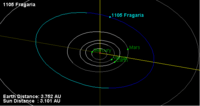1105 Fragaria
| Discovery | |
|---|---|
| Discovered by | K. Reinmuth |
| Discovery date | 1 January 1929 |
| Designations | |
Named after | Fragaria |
| Orbital characteristics[1] | |
| Epoch 31 July 2016 (JD 2457600.5) | |
| Uncertainty parameter 0 | |
| Observation arc | 87.34 yr (31901 days) |
| Aphelion | 3.3289972 AU (498.01089 Gm) |
| Perihelion | 2.6925714 AU (402.80295 Gm) |
| 3.010784 AU (450.4069 Gm) | |
| Eccentricity | 0.1056910 |
| 5.22 yr (1908.2 d) | |
Average orbital speed |
17.15757042 km/s (61 767.2535 km/h) |
| 357.2240° | |
| 0° 11m 19.184s / day | |
| Inclination | 10.96681° |
| 116.9191° | |
| 225.1991° | |
| Earth MOID | 1.69507 AU (253.579 Gm) |
| Jupiter MOID | 2.02764 AU (303.331 Gm) |
| Jupiter Tisserand parameter | 3.213 |
| Physical characteristics | |
Mean radius | 18.515±1.9 km |
| 10.88 h (0.453 d) | |
| 0.1186±0.029 | |
| T | |
| 10.09 | |
|
| |

An image depicting the orbit of the asteroid.
1105 Fragaria (1929 AB) is Main-belt asteroid discovered on January 1, 1929, by Karl Wilhelm Reinmuth at the Landessternwarte Heidelberg-Königstuhl in Heidelberg, Germany. It was named after Fragaria, the genus of flowering plants in the rose family.[2] It is a member of the Eos family.
See also
References
- ↑ "1105 Fragaria (1929 AB)". JPL Small-Body Database. NASA/Jet Propulsion Laboratory. Retrieved 2 May 2016.
- ↑ Schmadel, Lutz (1992). Dictionary of Minor Planet Names, Volym 1. Berlin: Springer Verlag. ISBN 3-540-00238-3. Retrieved 2014-01-09.
External links
This article is issued from Wikipedia - version of the 11/8/2016. The text is available under the Creative Commons Attribution/Share Alike but additional terms may apply for the media files.